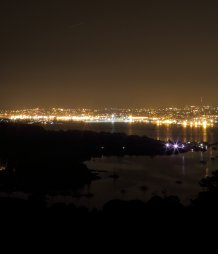Articles

Skyglow over Plymouth, Devon.
Image: James Duffy
Researchers track light pollution from space
Urban development and the growth of cities across Europe have resulted in a continental trend towards increasing brightness of night-time light. However, some regions show more complex patterns, and others feature large areas where the observed brightness has decreased.
These contrasting results are the key findings of a new study led by Professor Kevin J Gaston, and undertaken by researchers from the University of Exeter's Environment and Sustainability Institute (ESI) on the Penryn Campus.
Since the 1970s night-time satellite images of the Earth from space have provided a striking illustration of the extent of artificial light. Meanwhile, growing awareness of the adverse impacts of artificial light at night on scientific astronomy, human health, ecological processes and aesthetic enjoyment of the night sky has led to recognition of light pollution as a significant global environmental issue. Links between economic activity, population growth and artificial light are well documented in rapidly developing regions but this is the first study of its type to track both increases and decreases in light across Europe.
The team from the ESI used a novel method to analyse satellite images of European night-time lights over a 15 year period from 1995 to 2010.
Dr Jonathan Bennie, co-author of the recently published findings explained some of the key observations the team made: “Cornwall and the South West of England present fascinating examples of the changes in night-time light. While several parts of the region are getting brighter at night (coloured red on our maps below), mostly due to the expansion of new housing and industrial estates, some areas are getting dimmer. The locations of the china clay industry near St Austell, Bodmin Moor and outside Plymouth are clearly visible in blue, representing decreasing brightness. It’s possible to see that the night-time light associated with mineral extraction in both Cornwall and Devon has declined in line with activity at these sites.”
Speaking of areas which show increased night-time light Dr Bennie continued: “Elsewhere in Europe, many areas have shown rapid increases in brightness at night – Portugal and Italy are clear examples. These results were pretty much in line with our expectations. However, our most interesting results have identified those areas where the levels of night-time light observed have actually decreased as economic activity has been maintained or increased. Some towns in the South West have achieved this through improvement of their street light design and efficiency.
"While caution is needed in interpreting the data, an examination of the patterns of change can provide useful insights into the causes of changing brightness or levels of light pollution.
"On a European scale we detect decreases in brightness across much of northern Europe, including Belgium. Belgium is unique in Europe in having lighting installations for almost the entire length of its motorway system; during the time period covered by the study, lighting in the central reservations of many motorways was switched off for environmental and financial reasons for periods during the night.”
This last example shows that that it is possible to limit and even reduce the environmental impact of artificial light pollution while delivering cost and energy-saving benefits, both issues the researchers argue are of growing need and importance.
The ECOLIGHT research project exists to study the ecological effects of light pollution. It is funded by the European Research Council.
The ESI is working with businesses and enterprises across all sectors of the economy in Cornwall, the Isles of Scilly and beyond to translate research and expertise into innovative business practices, products and services in order to respond to the challenges of environmental change. It has been funded by the ERDF Convergence Programme (£22.9M) and the South West Regional Development Agency (£6.6M), with significant support from the Higher Education Funding Council for England.
Download Contrasting trends in light pollution across Europe based on satellite observed night time lights.
Date: 21 February 2014
